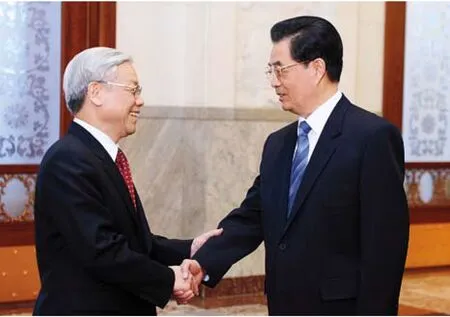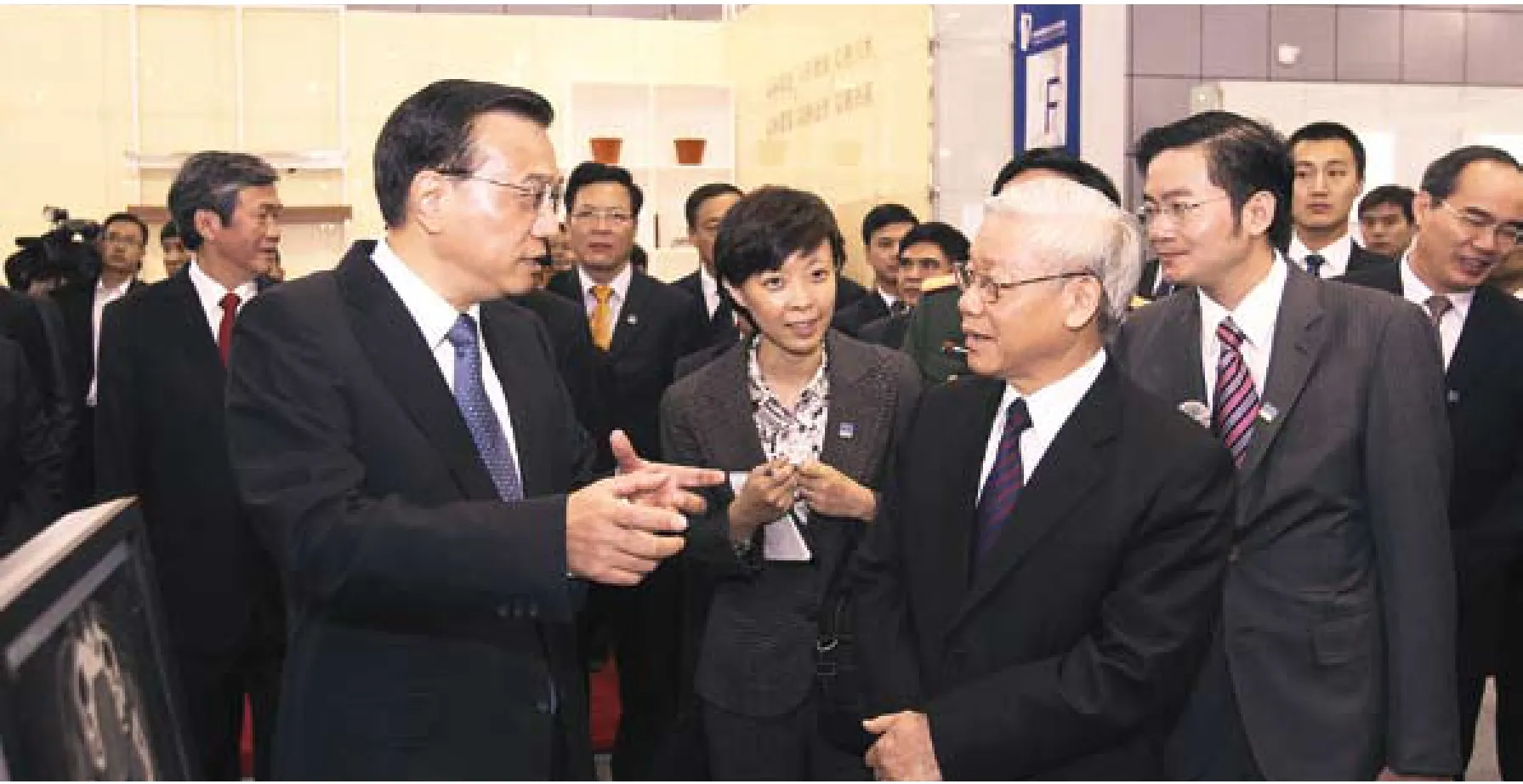Look on the Bright Side
2011-10-14ByYUYAN
By YU YAN
Look on the Bright Side
By YU YAN
China and Viet Nam downplay maritime disputes and expand economic cooperation

ZHANG DUO
China and Viet Nam vowed to strengthen maritime cooperation in“less sensitive fields” in disputed waters in the South China Sea. These felds include marine environmental protection, scientific research, search and rescue, and disaster reduction and prevention.
This pledge is part of an agreement on the basic principles guiding the settlement of maritime issues between the two countries signed during a recent visit of Nguyen Phu Trong, General Secretary of the Central Committee of the Communist Party of Viet Nam, to China.
During his visit, Trong held talks with Chinese leaders including President Hu Jintao, who is also general secretary of the Central Committee of the Communist Party of China, and Premier Wen Jiabao.
He also visited Zhongguancun, a hi-tech development zone in Beijing, and spent three days in south China’s Guangdong Province, calling for stronger economic ties between the province and Viet Nam.
Trong’s visit, from October 11-15, not only helped the two countries ease their maritime disputes, but also gave a boost to bilateral cooperation across the board, said Chinese analysts.
Maritime issues
“The biggest achievement of Trong’s visit was the signing of the agreement on the basic principles guiding the settlement of maritime issues between China and Viet Nam, which is significant for relieving the two countries’ territorial disputes in the South China Sea,” said Chu Hao, an assistant research fellow with the China Institutes of Contemporary International Relations.
The agreement made it clear that the long-term development of Sino-Vietnamese relations should be put above maritime issues. This is an important step forward, said Chu in an interview withBeijing Review.
“The agreement reflects the common political willingness of both sides to properly handle and resolve maritime issues,” said Chinese Foreign Ministry spokesman Liu Weimin.
It also showed the two countries have the capability and determination to solve their maritime disputes through consultations, he said.
病例随机选取15例左侧乳腺癌改良根治术后的放疗患者。设备:德国西门子公司Somatom Definition AS CT模拟机,美国 Med-Tec 250型乳腺托架,飞利浦Pinnacle 9.8放疗计划系统。
China and Viet Nam signed the agreement in Beijing on October 11. The six-point agreement is in accordance with the consensus reached by the leaders of China and Viet Nam and is based on a 1993 agreement on the basic principles for resolving territorial and border issues between the two countries.
China and Viet Nam should remain committed to friendly consultations in order to properly handle maritime issues and make the South China Sea a “sea of peace, friendship and cooperation,” the agreement said.
In the meantime, the agreement showed China’s stance of peaceful development. A major reason why the South China Sea issue has flared up is many Southeast Asian countries hold suspicion and anxiety about China’s rise, Chu said.
The signing of this agreement reaffrmed China’s policy of peaceful development. The move can promote China’s national image in Southeast Asia as well as its cooperation with Southeast Asian countries, he added.
The agreement is not only conducive to addressing maritime disputes between China and Viet Nam but will also have positive implications for the resolution of the South China Sea issue, said Zhang Jie, a researcher with the Institute of Asia-Pacifc Studies of the Chinese Academy of Social Sciences.
The South China Sea issue centers on the sovereignty of the Nansha Islands, a network of islands that stretches 1,000 km from north to south in the southeastern corner of the South China Sea. China has exercised jurisdiction over the islands throughout history. In the early 1970s after the region was found to be rich in oil and other natural resources, however, Southeast Asian countries including Viet Nam, the Philippines, Malaysia and Brunei began to claim sovereignty over all or part of the islands.
The marine economy accounts for about 30 percent of Viet Nam’s GDP, Zhang said. Viet Nam has recently released a sea strategy with a focus on developing marine resources.
During a visit to Singapore, Malaysia and Indonesia in mid-October, Japanese Foreign Minister Koichiro Gemba proposed putting the South China Sea issue under multilateral discussions.
In response, China expressed its objection. It will only make the issue even more complicated to put it under multilateral discussions, Liu said.
The issue should be solved through negotiations between countries directly concerned. This is a consensus reached in the Declaration on Conduct of Parties in the South China Sea signed between China and the Association of Southeast Asian Nations in 2002, he said.
China hopes countries outside the region can do things helpful for peace and stability in the South China Sea and support the efforts made by countries in the region to solve the issue through consultations and negotiations.
Trade and technology
Economic and trade cooperation between China and Viet Nam has witnessed rapid development in recent years, said Chu.
China has been the largest trade partner of Viet Nam for seven consecutive years from 2004 to 2010. Statistics from China’s Ministry of Commerce show trade between China and Viet Nam reached $30.1 billion in 2010. In the frst eight months of 2011, twoway trade hit $24.9 billion, up 39.9 percent over the same period last year.
China is willing to work with Viet Nam to further expand cooperation based on mutual respect, equality and mutual benefit, said Chinese Premier Wen Jiabao while meeting with Trong in Beijing.
The two sides should focus on implementing their five-year trade and economic cooperation plan for 2012-16 signed during Trong’s visit. They should promote balanced and sustained trade growth, encourage mutual investment, advance the development of economic cooperation zones and expand cooperation between border provinces, Wen said.
Trong agreed with Wen and said strengthening trade and economic cooperation is in the common interests of both countries.
Despite thriving trade cooperation, two major problems exist, Chu said. First, Viet Nam is dissatisfed with its big trade defcit with China. Offcial Chinese statistics show China’s exports to Viet Nam exceeded $23 billion in 2010, while its imports from Viet Nam were less than $7 billion.
The other problem is Viet Nam believes China’s investment in Viet Nam is too small. By the end of 2010, China’s direct investment in Viet Nam totaled $986.6 million, as opposed to $6.1 billion in Singapore and $1.9 billion in Myanmar, the top two destinations for Chinese investors in Southeast Asia, according to the 2010 Statistical Bulletin of China’s Outward Foreign Direct Investment issued by China’s Ministry of Commerce.
During the visit, Trong showed an intense interest in technological cooperation, as evidenced by his visit to the Zhongguancun technology hub in Beijing.
The two countries have great potential in hi-tech cooperation and Viet Nam expects to strengthen such cooperation with China, Trong said.
While staying in Guangdong, he visited a number of hi-tech enterprises including China’s leading telecom equipment makers, Huawei Technologies and ZTE Corp.
To develop the hi-tech industry is one of Viet Nam’s 2011 economic and social development goals. Previously, Viet Nam had attempted to acquire technology from the United States and Europe, but it didn’t work out. Now Viet Nam has shifted its focus to China, said Chu.
“As it deepens economic reliance on the sea, Viet Nam will give greater prominence to maritime rights and interests. For China, the South China Sea issue concerns its sovereignty. Both countries will therefore adopt a prudent attitude toward this issue. It is unlikely for them to make any substantive compromises.”
—Zhang Jie, a researcher with the Institute of Asia-Pacific Studies of the Chinese Academy of Social Sciences
For instance, Viet Nam has sent several science and technology delegations to China’s Guangxi Zhuang Autonomous Region, which borders Viet Nam, in recent years. The delegations studied Guangxi’s information technology, straw utilization technology, modern agricultural park construction and water-saving irrigation.
Guangxi also sent a delegation to the technology equipment exhibition in Viet Nam’s Quang Ninh Province last year. And a number of concrete technological cooperation projects have been carried out between the two sides.

DING LIN
